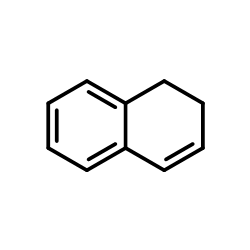Biotransformation of 1,2-dihydronaphthalene and 1,2-dihydroanthracene by rat liver microsomes and purified cytochromes P-450. Formation of arene hydrates of naphthalene and anthracene.
D R Boyd, N D Sharma, R Agarwal, R A McMordie, J G Bessems, B van Ommen, P J van Bladeren
Index: Chem. Res. Toxicol. 6(6) , 808-12, (1993)
Full Text: HTML
Abstract
Both 1,2-dihydronaphthalene and 1,2-dihydroanthracene were hydroxylated at the benzylic (1-) or the allylic (2-) position by rat liver microsomes and purified cytochrome P-450 enzymes to yield "arene hydrates". Two other classes of metabolites were formed, the dehydrogenation products naphthalene and anthracene, and trans-1,2-dihydroxy-1,2,3,4-tetrahydronaphthalene and its anthracene analog as products of the classical expoxide pathway. Regioselectivity (hydroxylation at benzylic or allylic positions) and stereoselectivity (hydroxylation at pro-R or pro-S hydrogen atoms) during metabolism of dihydroarenes to yield arene hydrates were found to be dependent upon the nature of the inducing agents used during pretreatment of the rats and thus the level of particular P-450 enzymes. This selectivity was more pronounced for anthracene than for naphthalene. Naphthalene and anthracene were formed enzymatically by direct dehydrogenation of the dihydro compounds rather than by dehydration of the arene hydrate metabolites. A general mechanism involving the intermediacy of benzylic and resonance-stabilized allylic carbon radicals can account for the formation of both enzyme-catalyzed hydroxylation (arene hydrate) and dehydrogenation (arene) metabolites of dihydroarene substrates.
Related Compounds
| Structure | Name/CAS No. | Molecular Formula | Articles |
|---|---|---|---|
 |
dihydronaphthalene
CAS:447-53-0 |
C10H10 |
|
'Bridged' stilbene derivatives as selective cyclooxygenase-1...
2007-09-15 [Bioorg. Med. Chem. 15 , 6109-18, (2007)] |
|
Organocatalytic asymmetric Friedel-Crafts alkylation/cascade...
2007-06-14 [Chem. Commun. (Camb.) (22) , 2228-30, (2007)] |
|
Asymmetric epoxidation using a singly-bound supported Katsuk...
2002-04-21 [Chem. Commun. (Camb.) (8) , 886-7, (2002)] |
|
Indatraline: synthesis and effect on the motor activity of W...
2011-01-01 [Molecules 16(11) , 9421-38, (2011)] |
|
Initial reactions in the oxidation of 1,2-dihydronaphthalene...
1996-12-01 [Appl. Environ. Microbiol. 62(12) , 4388-94, (1996)] |